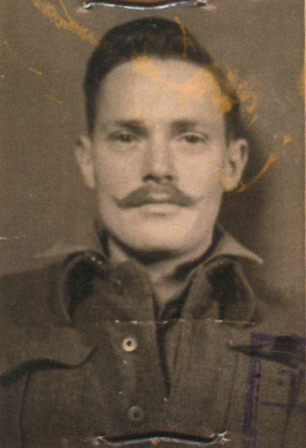 Ralph had always wanted to be a surgeon, but his father had other dreams for his only son. He insisted that Ralph join him in his vulcanizing business, reconditioning tyres. After each exasperating day Ralph would walk up the road to Johannesburg’s only Revisionist newspaper, “The Jewish Herald.” It was 1946 and the Jews were fighting for their homeland. The newspaper’s rhetoric appealed to him, and moreover, the Irgun Zvai Leumi (Etzel) was part of the forces loosening the British grip on Palestine. The fervent Zionism of the newspaper people influenced him, and he joined the Betar Movement. Many of the Betarim had taken an oath to join Etzel.
Ralph had always wanted to be a surgeon, but his father had other dreams for his only son. He insisted that Ralph join him in his vulcanizing business, reconditioning tyres. After each exasperating day Ralph would walk up the road to Johannesburg’s only Revisionist newspaper, “The Jewish Herald.” It was 1946 and the Jews were fighting for their homeland. The newspaper’s rhetoric appealed to him, and moreover, the Irgun Zvai Leumi (Etzel) was part of the forces loosening the British grip on Palestine. The fervent Zionism of the newspaper people influenced him, and he joined the Betar Movement. Many of the Betarim had taken an oath to join Etzel.
Ralph became involved in the secret training at the Rivonia Estate, about 10 miles outside Johannesburg, which belonged to Harry Elias Green, whose son Hymie was also a member of Betar and later volunteered and served in the same battalion as Ralph. Weekend training took place at a Jewish-owned farm near Witbank in the Transvaal.
Ralph and the other Betarim spent many a long night under the leadership of Shulamit Becker and Morrie Edges, printing news pamphlets on a duplicating machine in two homes, one in Orange Grove and the other in Oaklands. These pamphlets were used to disseminate information and propaganda received from the Irgun in British-mandated Palestine. Much of this information was political, stating the Irgun’s beliefs and its attitude in the current situation. The pamphlets were sent to members of the South African Parliament, newspaper editors, and other opinion makers.
The British had interned high-ranking officers of the Irgun and the Stern Gang in an old army camp, Gilgil, near Nakuru in Northern Kenya. A meticulous escape plan was prepared for late March 1948. Passports were needed to cross the border into the Belgian Congo. Ralph was one of the six Betarim who handed their passports to the Irgun to be used by the six escapees. Others included Monty Celender, Benny Grusin, Morrie Ringer and Solly Josman. The escape was successful and by April 4th 1948 the men were walking freely in the streets of Paris. The escape was announced by the Kenya Government on April 15th. Needless to say, the British were furious.
Eventually, Ralph and other Betarim were due to leave for Israel. Ralph used the passport of a friend, Cecil Wolluch, leaving Palmietfontein International Airport in early July. In those days it took 4-5 days to reach Rome and required spending nights at various stopovers in Africa.
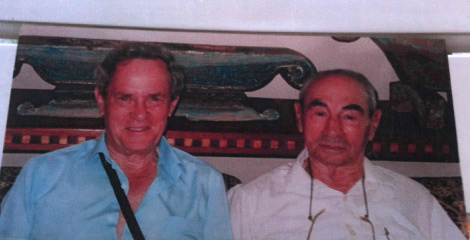
Ralph Yodaiken and Niko (taken sometime in the 1990s). Ralph’s passport enabled Niko to cross the Kenya/Congo border and reach Paris safely via the Belgian Congo at the end of March 1948.
In addition, their plane broke down in Tobruk and they had to wait for it to be repaired. They eventually reached Milan and were sent to one of the two displaced persons camps used by the Etzel in Italy. They went to Villa Forragiano on Lake Maggiore in Northern Italy. The majority of the refugees there were Romanians. Ralph’s group’s stay was an extended one.
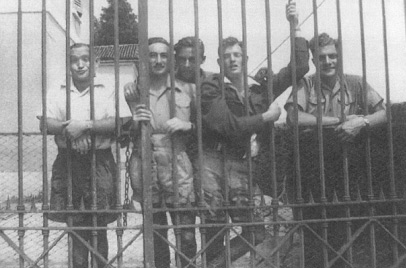
“Agter die tralies” at Villa Forragiano Displaced Persons Camp
Left to Right: David Wolf, David Magid, Louis Sack, Ralph Yodaiken, Eli Reef.
(Photo: Louis Sack)
While he was there, his mother Audrey arrived in Haifa on the ship “Amal” on July 29th 1948 to search for her son. She had flown north to Rome before sailing to Israel. Ralph (under the name Cecil Wolluch) finally arrived with his group in Haifa on the “Kedmah” on August 20th 1948. Other Betarim who arrived together with Ralph were Lou Sack, the brothers Joe and Nick Goldstein, Bernard Green, Morrie Ringer, Monty Celender, Benny Grusin, David Wolf, Eli Reef, and Charles Berman. The “Kedmah” had also carried some 470 refugees from the displaced persons camps.
The volunteers were sent to the Tel Litwinsky absorption camp near Tel Aviv. They were given uniforms, drilled for two weeks and then sent to various units. Ralph chose the 89th Mechanized Commandos, then under the command of Moshe Dayan. The battalion was stationed at an old school in Ben Shemen. Having arrived using the passport of Cecil Wolluch, Ralph continued using that name. There was no Hebrew equivalent of Cecil, so he was called Churchill. Ralph was allocated a room with two cots which he shared with Abe Goosberg, a Dutch volunteer. Abe was spare, wiry, and as strong as anyone else of his height, 5 feet six inches was, and he turned out to be a single-minded, steely-eyed killer. Abe would remain Ralph’s roommate for almost the entire war. Abe also made the best potato latkes ever, wherever they went – in the Galilee, in the Negev, in tents, on hills and in valleys, fried over a primus stove which he hitched onto the shoulder straps of his military rucksack.
Over the next few days Ralph met the rest of his Anglo-Saxon Platoon (See Note*).
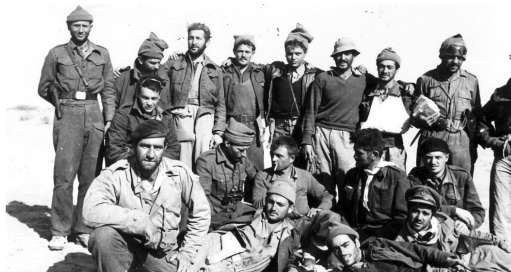
Back Row Left to Right: Unidentified; unidentified; unidentified; Ralph Yodaiken (South Africa);
Johnny Nakan (South Africa); unidentified, Michael (Jock) Klemitz (Scotland);
Front Row: Far Left, Mike Isaacson (South Africa); Second from right: Reg Sagar (South Africa);
far right Gerry Braude (USA);Behind Mike Isaacson – Harold Sher (South Africa).
One of them was a London-born Irish Catholic, Paddy, who together with a Scot named Harry had deserted the British Army after witnessing the massacre of 80 Jews on April 13th 1948, mainly leading professors and doctors who were killed in a 7-hour attack by the Arabs on their convoy to the Hadassah Hospital and the Hebrew University on Mount Scopus. Paddy and Harry were disgusted with the officers and NCOs who didn’t order any rescue attempts by the numerous British Army posts on the road to Mount Scopus. Paddy and Harry found their way to Tel Aviv and were recruited into the new 89th Commando Battalion being formed by Moshe Dayan. Everyone in the platoon spoke English as their primary or secondary language. The battalion, including the platoon, became a fierce fighting unit. Paddy was to remark that in his years in the British Army during World War II he had never come across a braver group of fighters, many of them 17- and 18- year olds.
The 89th was part of the 8th Armoured Brigade commanded by the founder of the Palmach, the “Old Man,” Yitzhak Sadeh. It included the 82nd Tank Battalion of an English-speaking “B” Company manning three heavy tanks, two Cromwells (stolen by British deserters), and one Sherman acquired by bribing a group of British soldiers ordered to destroy a number of them by pushing them over a cliff near Kibbutz Beit Oren, and an “A” Company of some eight light French tanks plus a “C” Company of half-tracks and jeeps. The “A” and “C” Companies were manned mainly by East European Jewish survivors.
The 8th Brigade also included the 88th Mortar Battalion. This brigade, including Ralph’s “B” Company, was supported by two field artillery batteries, commanded by British and Australian Machal members and a number of Machal members from other countries, as well as a complete English-speaking 4th Troop of anti-tank guns commanded by an American. They were all involved in the attack on the Iraq-el-Suweidan fortress, known as the “Monster on the Hill,” which was finally captured on November 9th at the conclusion of “Operation Yoav,” after seven previous failed attempts. Ralph was a member of the South African squad led by Reg Sagar, the first to penetrate the large hole blasted in the wall of the fortress.
In the last operations of 1948 “Operation Horev” and “Operation Ayin” the 89th captured the main Egyptian outpost “Auja-el-Hafir,” encountering murderous fire. During the course of the attack, Mike Isaacson’s half-track was stalled because of starter problems. Alerted by wounded Reg Sagar, Ralph ran almost a mile, and brought his half-track down under this heavy fire to tow Isaacson out until the engine started again. Ralph proudly accepted the white flag of surrender from the Egyptians.
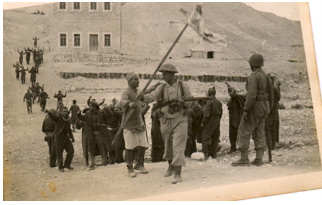
Ralph Yodaiken accepting the white flag of surrender from the Egyptians at Auja-el-Hafir.
(Photo: Mike Isaacson)
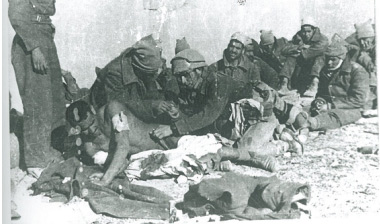
At Auja-el-Hafir a wounded Egyptian prisoner receives aid from a medic of the 89th Battalion.
(Photo: Mike Isaacson)
On his return to South Africa, Ralph qualified as a doctor and eventually became a well-known physician in Bethesda, Maryland, in the USA, after settling there with his family.
Note *
Known members of the 89th English-speaking platoon including some later arrivals:
|
South Africa: |
|
|
Reg Sagar and Ralph “Bull” Bernstein (both Rhodesians) |
Cousins. Sagar was to be cited for bravery in the capture of Auja-el-Hafir (Nitzana) |
|
Jimmy Leon Kantey |
Seriously wounded in “Operation Dani” starting on 10th July, before Ralph arrived in Israel. |
|
Leslie Marcus |
Cited for bravery in action at Beit Guvrin during “Operation Yoav” in October |
|
Mike Isaacson |
Dubbed “The Fighting Tiger” by the Battalion Commander who succeeded Moshe Dayan. |
|
Ivor Sheinbaum |
Badly wounded at the battle for Auja. |
|
Julian Schragenheim |
Joined the group of Nazi-hunters after the War of Independence. |
|
Harold Sher, Bill Lehr, Arnold Isaacson (cousin to Mike), Horace (Uri) Malinsky, Dov Davis, and Johnny Nakan. |
|
|
Hymie Green and Michael Kruss |
Medics in the 89th Battalion |
|
UK: |
|
|
Bert Fagin, Paddy Cooper, Harry, Eric, Johnny, Jock and his Scottish friend Michael Klemitz |
Michael transferred from 7th Brigade after “Operation Hiram” at the end of October. |
|
USA: |
|
|
Phil Balkin |
Killed in action at Auja |
|
Gerald Braude |
|
|
Canada |
|
|
Bernard Eisen |
|
|
Europe: |
|
|
Steven |
Who deserted from the USA Occupation Army in Germany |
|
Abe Goosberg |
The potato latkes king from Holland |
|
Others: |
|
|
Yochanan Sender |
A German Jew who had lived out the war in the Black Forest and had seen his family killed in Nazi camps. Now he lived to kill. |
|
Name unknown |
Another British deserter. |
Sources:
1. Dr. Naomi Baumslag (Ralph Yodaiken’s widow) as related to her by Ralph.
2. Information contained in the book “South Africa’s 800” by Henry Katzew.
3. Additional historical content by Machal researcher Joe Woolf.

